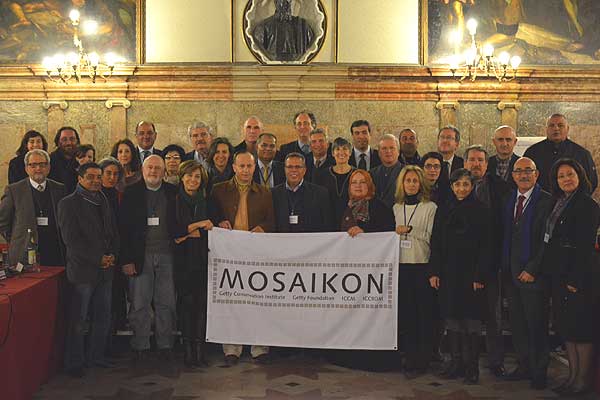 Partners of the MOSAIKON Project recently met in Venice to take stock of the programme and its results since its inception in 2008, and to look towards the future and priority needs. MOSAIKON is a multi-partner initiative to improve mosaics conservation in the southern and eastern Mediterranean through capacity building and information sharing.
Partners of the MOSAIKON Project recently met in Venice to take stock of the programme and its results since its inception in 2008, and to look towards the future and priority needs. MOSAIKON is a multi-partner initiative to improve mosaics conservation in the southern and eastern Mediterranean through capacity building and information sharing.
The Mediterranean region is rich in mosaics that are housed in museums or located on archaeological sites. Their conservation can be hindered by a variety of factors, ranging from a lack of policies to regulate their protection, to elevated risks in those countries affected by civil unrest, to a shortage of publications on mosaics conservation in local languages.
The meeting, which took place from 17-19 January, examined these issues and discussed the results and success stories that have come out of MOSAIKON over the past seven years. Amongst the achievements presented, of course those of alumni were underlined, as the programme’s training activities have been indispensible in enabling professionals from the region to improve the condition of mosaics in their home countries and institutions.
Hicham Rguig, an archaeologist from Morocco, is one such example. After taking part in an ATHAR course in 2007 on the conservation of heritage sites, and an ATHAR-MOSAIKON course on conservation and management of mosaics on archaeological sites in 2010, he obtained seed money from the Getty Foundation to develop and implement conservation work on the mosaics of the archaeological site of Chellah. Thanks to the training and subsequent grant, he and his team were better able to treat the mosaics and create an action plan for their maintenance and interpretation, which has had a positive effect on tourism and the local economy.
As the meeting examined current conditions of mosaics conservation in the region, priority needs and future steps were a key topic of discussion. A series of recommendations were drafted, which will be pursued by partners and states present at the meeting. These include raising awareness of the significance of mosaics and their benefit as shared heritage for future generations.
"ICCROM is pleased with the results of this meeting,” said ICCROM Director-General, Stefano De Caro. “The professionals and leading figures of conservation institutions recognize the important achievements of the programme, especially in relation to capacity building. MOSAIKON has benefited a large number of professionals working on mosaic heritage, and an important additional result is the network of technicians who have formed friendships extending beyond national borders. To consolidate and enlarge the impact of this network, ICCROM has been working on a MOSAIKON compendium of key published articles in Arabic, and is happy to announce that its new digital journal, Fasti Online Archaeological Conservation, will provide a substantial tool for disseminating knowledge and experiences on conservation projects in this field."
MOSAIKON is a collaborative long-term initiative between ICCROM, the Getty Conservation Institute, the Getty Foundation and the International Committee for the Conservation of Mosaics (ICCM). The commitment and generosity of the MOSAIKON partners have been the backbone of its successes. For more information about MOSAIKON visit the Getty Conservation Institute’s dedicated web page.
Member States represented: Algeria, Cyprus, Egypt, Israel, Italy, Jordan, Lebanon, Libya, Morocco, Tunisia, Turkey, United States
